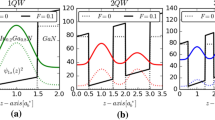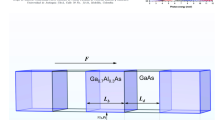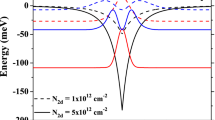Abstract
In this paper, we employed numerical modeling to investigate the influence of crucial parameters, namely electric field, confinement parabolicity, compositions, and structure parameters, on the electron probability, impurity polarizability, diamagnetic susceptibility, and ionization energy of hydrogenic donor impurities within a modified ∩-shaped potential. The Schrödinger equation is solved using the finite element approach within the framework of the effective mass theory to analyze the resulting electronic properties. Our results demonstrate a significant impact of these factors on both electrons and impurities, with the ability to fine-tune these properties through parameter adjustments. These findings hold significant implications for the advancement of precise and efficient III-nitride-based optoelectronic devices, including solar cells, photodetectors, and lasers.
Graphical abstract

Effect of Applied Vertical Electric Field on Electron Probability Density in Inverted Parabolic Quantum Well with Varying Degrees of Confinement







Similar content being viewed by others
Data availability statement
This manuscript has no associated data or the data will not be deposited. [Authors’ comment: All the data pertaining to the topic has been thoroughly included and described within the text of this article. Hence, there is no need for a separate data deposition.]
References
K.Y. Cheong, Two-Dimensional Nanostructures for Energy-Related Applications (CRC Press, Boca Raton, 2017)
A. Jasik et al., The influence of the growth rate and V/III ratio on the crystal quality of InGaAs/GaAs QW structures grown by MBE and MOCVD methods. J. Cryst. Growth 311(19), 4423–4432 (2009). https://doi.org/10.1016/j.jcrysgro.2009.07.032
C. Abbas et al., Spin relaxation of indirect excitons in asymmetric coupled quantum wells. Superlattices Microstruct. 122, 643–649 (2018)
A.R. Adams, Strained-layer quantum-well lasers. IEEE J. Sel. Top. Quantum Electron. 17(5), 1364–1373 (2011). https://doi.org/10.1109/JSTQE.2011.2108995
D. Atkinson, G. Parry, E.J. Austin, Modelling of electroabsorption in coupled quantum wells with applications to low voltage optical modulation. Semicond. Sci. Technol. 5(6), 516 (1990)
P.A. Belov, Energy spectrum of excitons in square quantum wells. Phys. E Low-Dimens. Syst. Nanostruct. 112, 96–108 (2019)
W.P. Hong, A. Zrenner, O.H. Kim, J. Harbison, L. Florez, F. Derosa, Characteristics of AlGaAs/GaAs quantum-well delta-doped channel FET (QUADFET). IEEE Trans. Electron Devices 37(8), 1924–1926 (1990)
H. Daembkes, G. Weimann, Multiple quantum well AlGaAs/GaAs field-effect transistor structures for power applications. Appl. Phys. Lett. 52(17), 1404–1406 (1988)
P.P. Ruden, M. Shur, A.I. Akinwande, J.C. Nohava, D.E. Grider, J. Baek, AlGaAs/InGaAs/GaAs quantum well doped channel heterostructure field effect transistors. IEEE Trans. Electron Devices 37(10), 2171–2175 (1990)
Y. Alaskar et al., Theoretical and experimental study of highly textured GaAs on silicon using a graphene buffer layer. J. Cryst. Growth 425, 268–273 (2015)
M.H. Crawford, J. Han, M.A. Banas, S.M. Myers, G.A. Petersen, J.J. Figiel, Optical spectroscopy of Ingan epilayers in the low indium composition regime. MRS Online Proc. Libr. OPL 595, F99W11.41 (1999). https://doi.org/10.1557/PROC-595-F99W11.41
S.Y. Karpov, Carrier localization in InGaN by composition fluctuations: implication to the “green gap.” Photonics Res. 5(2), A7–A12 (2017)
M. Beeler, E. Trichas, E. Monroy, III-Nitride semiconductors for intersubband optoelectronics: a review. Semicond. Sci. Technol. 28(7), 074022 (2013)
M.O. Manasreh (ed.), III-nitride semiconductors: electrical, structural and defects properties (2000)
M. Kuzuhara, H. Tokuda, Low-loss and high-voltage III-nitride transistors for power switching applications. IEEE Trans. Electron Devices 62(2), 405–413 (2015). https://doi.org/10.1109/TED.2014.2359055
M. Razeghi, III-nitride optoelectronic devices: from ultraviolet toward terahertz. IEEE Photonics J. 3(2), 263–267 (2011)
E. Kasapoglu, F. Ungan, H. Sari, I. Sökmen, M.E. Mora-Ramos, C.A. Duque, Donor impurity states and related optical responses in triangular quantum dots under applied electric field. Superlattices Microstruct. 73, 171–184 (2014)
E. Kasapoglu, F. Ungan, H. Sari, I. Sökmen, The diamagnetic susceptibilities of donors in quantum wells with anisotropic effective mass. Superlattices Microstruct. 46(6), 817–822 (2009)
E. Kilicarslan, S. Sakiroglu, M. Koksal, H. Sari, I. Sokmen, The effects of the magnetic field and dielectric screening on the diamagnetic susceptibility of a donor in a quantum well with anisotropic effective mass. Phys. E Low-Dimens. Syst. Nanostruct. 42(5), 1531–1535 (2010)
A.J. Peter, Diamagnetic susceptibility of a laser dressed donor in a quantum well. Superlattices Microstruct. 47(3), 442–451 (2010)
S. Rajashabala, K. Navaneethakrishnan, Effects of dielectric screening and position dependent effective mass on donor binding energies and on diamagnetic susceptibility in a quantum well. Superlattices Microstruct. 43(3), 247–261 (2008)
B. Chouchen, M.H. Gazzah, A. Bajahzar, H. Belmabrouk, Numerical modeling of InGaN/GaN pin solar cells under temperature and hydrostatic pressure effects. AIP Adv. 9(4), 045313 (2019)
B. Chouchen, M.H. Gazzah, A. Bajahzar, H. Belmabrouk, Numerical modeling of the electronic and electrical characteristics of InGaN/GaN-MQW solar cells. Materials 12(8), 1241 (2019)
R. En-nadir, H. El Ghazi, A. Jorio, I. Zorkani, Inter and intra band impurity-related absorption in (In, Ga) N/GaN QW under composition, size and impurity effects, in MATEC Web of Conferences, EDP Sciences (2020)
İ Karabulut, H. Şafak, M. Tomak, Intersubband resonant enhancement of the nonlinear optical properties in compositionally asymmetric and interdiffused quantum wells. J. Appl. Phys. 103(10), 103116 (2008). https://doi.org/10.1063/1.2937189
I. Maouhoubi, R. En-nadir, K. El bekkari, I. Zorkani, A. Ouazzani Tayebi Hassani, A. Jorio, Effects of applied magnetic field and pressure on the diamagnetic susceptibility and binding energy of donor impurity in GaAs quantum dot considering the non-parabolicity model’s influence. Philos. Mag. 0(0), 1–18 (2022). https://doi.org/10.1080/14786435.2022.2141469
I. Maouhoubi, R. En-nadir, I. Zorkani, A.O.T. Hassani, A. Jorio, The effects of the dielectric screening, temperature, magnetic field, and the structure dimension on the diamagnetic susceptibility and the binding energy of a donor-impurity in quantum disk. Phys. B Condens. Matter 646, 414371 (2022)
M. Solaimani, Binding energy and diamagnetic susceptibility of donor impurities in quantum dots with different geometries and potentials. Mater. Sci. Eng. B 262, 114694 (2020)
E. Iqraoun, A. Sali, K. El-Bakkari, M.E. Mora-Ramos, C.A. Duque, Binding energy, polarizability, and diamagnetic response of shallow donor impurity in zinc blende GaN quantum dots. Micro Nanostruct. 163, 107142 (2022). https://doi.org/10.1016/j.spmi.2021.107142
A.L. Morales, N. Raigoza, E. Reyes-Gómez, J.M. Osorio-Guillén, C.A. Duque, Impurity-related polarizability and photoionization-cross section in GaAs–Ga1−xAlxAs double quantum wells under electric fields and hydrostatic pressure. Superlattices Microstruct. 45(6), 590–597 (2009). https://doi.org/10.1016/j.spmi.2009.03.001
R. En-Nadir, H. El Ghazi, A. Jorio, I. Zorkani, Ground-state shallow-donor binding energy in (In, Ga) N/GaN double QWs under temperature, size, and the impurity position effects. J. Model. Simul. Mater. 4(1), 1–6 (2021)
W. Que, Excitons in quantum dots with parabolic confinement. Phys. Rev. B 45(19), 11036–11041 (1992). https://doi.org/10.1103/PhysRevB.45.11036
H. El Ghazi, A. Jorio, I. Zorkani, Impurity binding energy of lowest-excited state in (In, Ga) N-GaN spherical QD under electric field effect. Phys. B Condens. Matter 426, 155–157 (2013)
R. En-nadir, H. El-ghazi, Theoretical study of ISB conduction optical absorption and impurity binding energy associated with lowest excited states in QW with a new modulated potential. J. Theor. Appl. Phys. (2023). https://doi.org/10.30495/jtap.172317
R. En-nadir, H. El Ghazi, W. Belaid, A. Jorio, I. Zorkani, Intraconduction band-related optical absorption in coupled (In, Ga)N/GaN double parabolic quantum wells under temperature, coupling and composition effects. Results Opt. 5, 100154 (2021). https://doi.org/10.1016/j.rio.2021.100154
H. Belmabrouk et al., Modeling the simultaneous effects of thermal and polarization in InGaN/GaN based high electron mobility transistors. Optik 207, 163883 (2020)
H. ElGhazi, R. En-nadir, H. Abboudi, F. Jabouti, A. Jorio, I. Zorkani, Two-dimensional electron gas modeling in strained InN/GaN hetero-interface under pressure and impurity effects. Phys. B Condens. Matter 582, 411951 (2020). https://doi.org/10.1016/j.physb.2019.411951
R. En-nadir et al., The electric and magnetic field effects on the optical absorption in double QWs with squared, U-shaped and V-shaped confinement potentials. Philos. Mag. 0(0), 1–14 (2022). https://doi.org/10.1080/14786435.2022.2145027
V. Delgado, Quantum probability distribution of arrival times and probability current density. Phys. Rev. A 59(2), 1010–1020 (1999). https://doi.org/10.1103/PhysRevA.59.1010
H. El Ghazi, A. JohnPeter, Impurity-related binding energy in strained (In, Ga)N asymmetric coupled QWs under strong built-in electric field. Solid State Commun. 201, 5–8 (2015). https://doi.org/10.1016/j.ssc.2014.09.024
P.S. Kalpana, K. Jayakumar, Impurity states and the diamagnetic susceptibility of a donor in a GaAs/AlxGa1–x As triangular quantum well under hydrostatic pressure. J. Phys. Chem. Solids 110, 364–369 (2017). https://doi.org/10.1016/j.jpcs.2017.06.031
S.Y. López, N. Porras-Montenegro, C.A. Duque, Binding energy and density of shallow impurity states in GaAs–(Ga, Al) As quantum wells: effects of an applied hydrostatic stress. Semicond. Sci. Technol. 18(7), 718 (2003)
W. Belaid, H. El Ghazi, I. Zorkani, A. Jorio, Pressure-related binding energy in (In, Ga) N/GaN double quantum wells under internal composition effects. Solid State Commun. 327, 114193 (2021)
J.A. Brum, C. Priester, G. Allan, Electric field dependence of the binding energy of shallow donors in GaAs-Ga1–xAlx As quantum wells. Phys. Rev. B 32(4), 2378–2381 (1985). https://doi.org/10.1103/PhysRevB.32.2378
Z. Xiao, J. Zhu, F. He, Effect of the parabolic potential on the binding energy of a hydrogenic impurity in a spherical quantum dot. Superlattices Microstruct. 19(2), 137–149 (1996). https://doi.org/10.1006/spmi.1996.0017
G. Rezaei, N.A. Doostimotlagh, External electric field, hydrostatic pressure and conduction band non-parabolicity effects on the binding energy and the diamagnetic susceptibility of a hydrogenic impurity quantum dot. Phys. E Low-Dimens. Syst. Nanostruct. 44(4), 833–838 (2012)
A.L. Morales, A. Montes, S.Y. López, C.A. Duque, Simultaneous effects of hydrostatic stress and an electric field on donors in a GaAs-(Ga, Al)As quantum well. J. Phys. Condens. Matter 14(5), 987 (2002). https://doi.org/10.1088/0953-8984/14/5/304
Acknowledgements
We would like to express our sincere gratitude and heartfelt appreciation to our esteemed collaborators from Hungary and Turkey. Their invaluable contribution and insightful discussions have been instrumental in enhancing the quality of this work. Without their support, this project would not have been possible.
Funding
Not applicable.
Author information
Authors and Affiliations
Contributions
Conceptualization, RE, MT, SEZ and WB; resources, RE and HE; writing—original draft preparation, RE and HE; methodology, RE and HE; writing—review and editing, LI and IZ; supervision, HE and AJ; project administration, HE and IZ. All authors have read and agreed to the published version of the manuscript.
Corresponding author
Ethics declarations
Institutional review board statement
Not applicable.
Informed consent statement
Not applicable.
Rights and permissions
Springer Nature or its licensor (e.g. a society or other partner) holds exclusive rights to this article under a publishing agreement with the author(s) or other rightsholder(s); author self-archiving of the accepted manuscript version of this article is solely governed by the terms of such publishing agreement and applicable law.
About this article
Cite this article
En-nadir, R., El Ghazi, H., Tihtih, M. et al. Exploring the electronic properties of shallow donor impurities in modified ∩-shaped potential: effects of applied electric field, parabolicity, compositions, and thickness. Eur. Phys. J. B 96, 78 (2023). https://doi.org/10.1140/epjb/s10051-023-00539-6
Received:
Accepted:
Published:
DOI: https://doi.org/10.1140/epjb/s10051-023-00539-6




